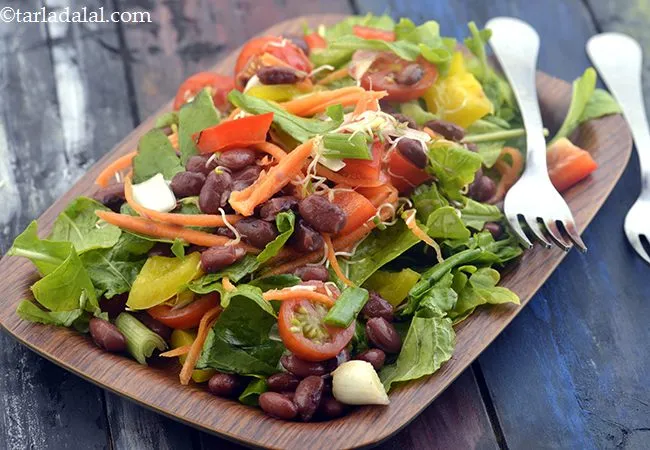Search & Articles
Search from thousands of articles from sabzi, roti, chawal, dal, paneer, Indian recipes to health articles.
Rajma Benefits, Kidney Beans
This article page has been viewed 142234 times

Rajma benefits, Kidney beans
Table of Content
10 Health Benefits of Rajma, Red Kidney Beans
Rajma, or kidney beans, holds a special place in the Indian diet. It's not just a beloved comfort food but also a nutritional powerhouse that aligns perfectly with both traditional eating habits and modern health needs. Its popularity, particularly in North Indian cuisine where "Rajma Chawal" (kidney beans with rice) is an iconic dish, comes from its rich, earthy flavor and creamy texture when cooked. Beyond its culinary appeal, rajma is a significant source of plant-based protein, making it essential for vegetarian and vegan diets common across India. It provides vital amino acids for muscle growth and repair, especially when paired with staples like rice.
Rajma's health benefits are particularly relevant in the Indian context. It's exceptionally rich in dietary fiber, which aids digestion, promotes fullness, and helps manage blood sugar levels—a crucial benefit given the rising prevalence of diabetes in India. Its low glycemic index ensures a slow and steady release of glucose into the bloodstream, making it a "diabetic-friendly" legume. Rajma is also a good source of iron, helping to combat anemia, a common nutritional deficiency, especially among women and children in India. Additionally, its potassium content supports blood pressure regulation, contributing to cardiovascular health. This blend of nutritional richness and versatility makes rajma an ideal component of a wholesome and balanced Indian diet.
1. Rajma is Good for Diabetics :
Rajma, commonly known as kidney beans, is an excellent dietary choice for individuals managing diabetes due to its remarkable nutritional composition. Its most significant benefit lies in its low glycemic index (GI), typically ranging around 22-29. This low GI means that rajma causes a very slow and gradual rise in blood sugar levels after consumption, unlike high-GI foods that lead to rapid spikes. This steady release of glucose is attributed to its unique carbohydrate structure, particularly a higher proportion of amylose, a type of starch that is digested more slowly than others.
Furthermore, rajma is exceptionally rich in dietary fiber, both soluble and insoluble. Soluble fiber forms a gel-like substance in the digestive tract, which further slows down the absorption of glucose into the bloodstream, helping to maintain stable blood sugar levels. Insoluble fiber adds bulk to the stool, promoting digestive health and regularity. Additionally, rajma is a significant source of plant-based protein. Protein helps to stabilize blood sugar levels by slowing down carbohydrate digestion and absorption, and also contributes to satiety, which is crucial for weight management—a key aspect of diabetes control. The combination of low GI, high fiber, and protein makes rajma a powerhouse legume for supporting blood sugar management.
Rajma is a complex carb with a Glycemic Index of 29 which is low. Low Glycemic index and its high fibre count will slow down the release of sugar thereby keeping you fuller for a longer time. So eating rajma is good for diabetics.
rajma recipe | Punjabi kidney bean curry | authentic Punjabi rajma | healthy rajma recipe
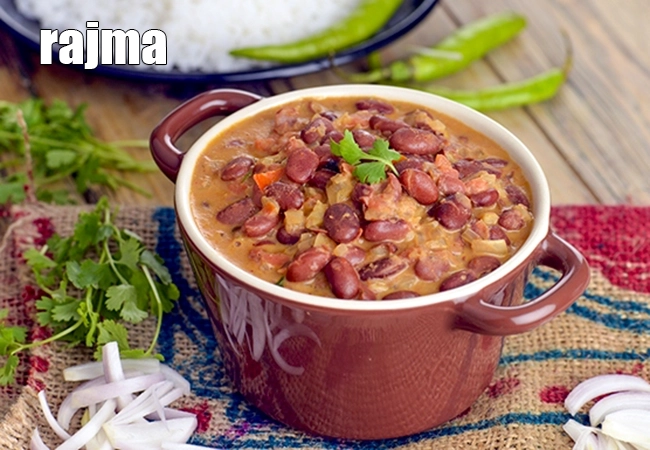
2. Rajma Controls Blood Pressure :
In the Indian dietary context, rajma (kidney beans) plays a significant role in managing and controlling blood pressure, a growing concern in the country. This benefit primarily stems from its rich content of potassium and magnesium, two crucial minerals that are essential for maintaining healthy blood pressure levels. Potassium acts as a counterbalance to sodium in the body; while excess sodium can lead to water retention and increased pressure on blood vessel walls, potassium helps to promote the excretion of sodium through urine. Furthermore, potassium works to relax blood vessels, thereby easing the flow of blood and reducing overall pressure within the arteries.
Beyond potassium, the significant presence of magnesium in rajma further contributes to its blood pressure-regulating properties. Magnesium plays a vital role in muscle and nerve function, including the relaxation of blood vessel walls. Its deficiency can contribute to hypertension, making rajma a valuable addition to the Indian diet for those at risk or managing high blood pressure. Additionally, the high fiber content in rajma aids in improving overall cardiovascular health by helping to lower cholesterol levels and contributing to better blood flow, all of which indirectly support healthy blood pressure. The widespread consumption of rajma in popular Indian dishes like Rajma Chawal makes it an accessible and culturally integrated food choice for promoting heart health and managing hypertension.
There is 15% of Potassium daily requirement in one cup of cooked Rajma. Potassium is critical for those with High Blood Pressure as it lessens the impact of sodium. Eating more Potassium Rich Foods will remove more sodium from your body through urine.
So if you are suffering from High Blood Pressure and taking medication, then the medicine works by taking out the sodium and potassium from the kidneys. So you need to up your Potassium intake in this case. Fruits and vegetables are a very good source of potassium.
Rajma Salad is a great way to add in fiber and potassium both. Just remember to control the amount of salt being added in the recipe as per the permissible amount prescribed for you by your doctor.
Rajma Salad Healthy Rajma Salad
3. Rajma helps Lowers Cholesterol and good for heart :
In the Indian dietary landscape, where cardiovascular health is a growing concern, rajma (kidney beans) stands out as a highly beneficial legume for lowering cholesterol and promoting a healthy heart. Its primary mechanism lies in its rich content of soluble fiber. When consumed, this soluble fiber forms a gel-like substance in the digestive tract. This gel binds with cholesterol and bile acids, preventing their reabsorption into the bloodstream and instead facilitating their excretion from the body. By effectively "flushing out" cholesterol, particularly the "bad" LDL cholesterol, rajma helps to reduce overall cholesterol levels, which is a key factor in preventing the build-up of plaque in arteries and reducing the risk of heart disease and stroke.
Beyond its cholesterol-lowering fiber, rajma contributes to heart health through its abundant supply of essential minerals like potassium and magnesium. In the Indian context, where diets might sometimes be high in sodium, potassium helps to counterbalance its effects by promoting sodium excretion and relaxing blood vessel walls, thereby aiding in blood pressure regulation. Magnesium also plays a crucial role in maintaining a healthy heart rhythm and overall cardiovascular function. The synergistic action of fiber, potassium, and magnesium makes rajma a holistic food for heart health, aligning well with the dietary recommendations for combating lifestyle diseases prevalent in India.
Rajma is a complex carb and rich in Fibre which helps in Lowering Cholesterol levels. Soluble fibre may reduce the absorption of cholesterol. Hence lowers total cholesterol and LDL cholesterol (the Bad cholesterol) therefore reducing the risk of heart disease. Soluble fibre creates the bile in the intestine to excreted in the stool.
The body needs cholesterol to make bile salts and hence the liver produces more LDL. So more bile salts made in the liver will result in more LDL cholesterol (bad cholesterol) being pulled out of the blood stream. So eat more soluble fibre.
bean and capsicum salad recipe | rajma, kabuli chana salad | protein rich Indian rajma salad with bell peppers | One serving of bean and capsicum salad has 24% protein , 57% fiber. 188 % Vitamin C, 89% Folic Acid, 40% Vitamin B1, 27% Calcium , 42% Iron, 41% Phosphorus, 38% Magnesium, 18% Potassium, 24% Zince of your Recommended Dietary Allowance ( RDA).
bean and capsicum salad recipe | rajma, kabuli chana salad | protein rich Indian rajma salad with bell peppers
4. Rajma is a Powerhouse of Protein :
Rajma, or kidney beans, are truly a powerhouse of protein, making them an invaluable component of a balanced diet, especially for vegetarians and vegans seeking to meet their daily protein requirements. A 100-gram serving of cooked rajma can provide approximately 8.7 grams of protein, contributing significantly to muscle growth, repair, and overall cellular function. This plant-based protein source is crucial for synthesizing enzymes, hormones, and antibodies, all of which are vital for a healthy and efficiently functioning body.
Beyond just the quantity, the quality of protein in rajma is also noteworthy. While it's considered an "incomplete" protein on its own (meaning it lacks all nine essential amino acids in sufficient quantities), it can be easily combined with complementary protein sources like rice or corn to form a "complete" protein. This makes the traditional Indian dish of Rajma Chawal (kidney beans with rice) an excellent example of how to achieve a complete amino acid profile through plant-based meals. Moreover, the protein in rajma contributes to increased satiety, helping individuals feel fuller for longer, which can be a beneficial factor for weight management and overall dietary adherence.
Rajma abounds in protein. A cup of rajma gives 17.1 gm of protein which helps in the maintenance of every cell and tissue of our body. It’s a remarkable substitute to protein brimming non-veg foods when consumed in the form of Rajma and Urad Dal.
Rajma and Urad Dal
5. Rajma is Good for Skin :
Zinc helps in building immunity, is good for skin, great Antioxidant and involved in adding glow to your skin while preventing the wrinkles.
carrot cucumber and rajma Salad in mint dressing recipe | vegetable salad with mint and lemon dressing | healthy weight loss vegetable salad | healthy Indian salad recipe for weight loss
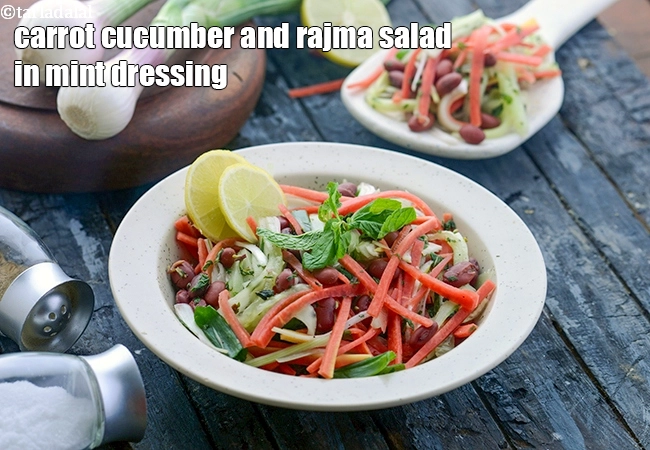
6. Rajma is Rich in Magnesium :
In the Indian diet, where vegetarianism is widespread and attention to micronutrient intake is crucial, rajma (kidney beans) stands out as a significant source of magnesium. This essential mineral plays a pivotal role in over 300 biochemical reactions in the body, ranging from muscle and nerve function to blood glucose control and blood pressure regulation. For Indians, who may face deficiencies in various micronutrients, the consistent inclusion of rajma in dishes like the ubiquitous Rajma Chawal offers a convenient and traditional way to boost magnesium intake. This contributes not only to strong bones and teeth, but also supports energy production and helps in reducing fatigue, making it a valuable legume for overall health and well-being in the Indian household.
One cup of cooked kidney beans has 26.2% of your daily Magnesium requirements. Magnesium helps in formation of bones and teeth and metabolism of calcium and potassium.
rajma dhokla | kidney bean dhokla | healthy rajma dhokla

7. Rajma helps Makes Bones Strong :
There is 13% of Calcium daily requirement in one cup of cooked Rajma. Calcium is a mineral that makes bones stay strong. The human body consistently remove small amounts of calcium from our bones and that has to be topped up with Calcium rich foods.
Calcium is a necessity for all … right from a newborn to an aged person, as the body’s need for calcium actually increases as one gets older. Try a one dish meal like Healthy Bean Quesadilla.
Healthy Bean Quesadilla
8. Rajma Gives you more Energy :
Rajma provides sustained energy due to its rich content of complex carbohydrates and dietary fiber. Unlike simple sugars that lead to a rapid energy spike followed by a crash, the complex carbohydrates in rajma are digested slowly, providing a steady and prolonged release of glucose into the bloodstream. This slow digestion, further regulated by its high fiber content, helps maintain stable blood sugar levels and prevents sudden drops in energy, making it an excellent food for sustained vitality throughout the day.
three bean salad recipe | rajma, kabuli chana and rangoon na vaal salad | healthy Indian kidney beans, chick peas and broad field beans salad | The three bean salad features an excellent combination of different beans tossed in a tantalizing lemony basil dressing. The beans offer an ideal low-cal way to consume protein and fibre, which will not only aid in weight loss but also help to keep cholesterol under check.
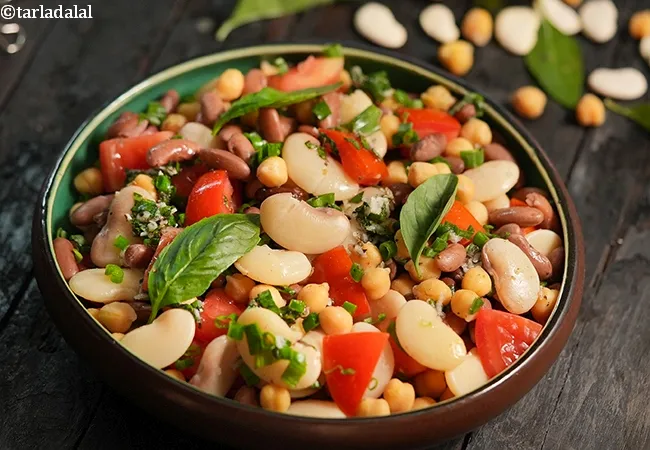 three bean salad recipe | rajma, kabuli chana and rangoon na vaal salad | healthy Indian kidney beans, chick peas and broad field beans salad |
three bean salad recipe | rajma, kabuli chana and rangoon na vaal salad | healthy Indian kidney beans, chick peas and broad field beans salad |
9. Rajma Keeps you leaner :
Being rich in Soluble Fibre , Rajma will keep you fuller for a longer time and will prevent you on binge eating.
kidney bean salad recipe | Mexican bean salad | Indian kidney bean salad with lemon garlic dressing | Mediterranean bean salad
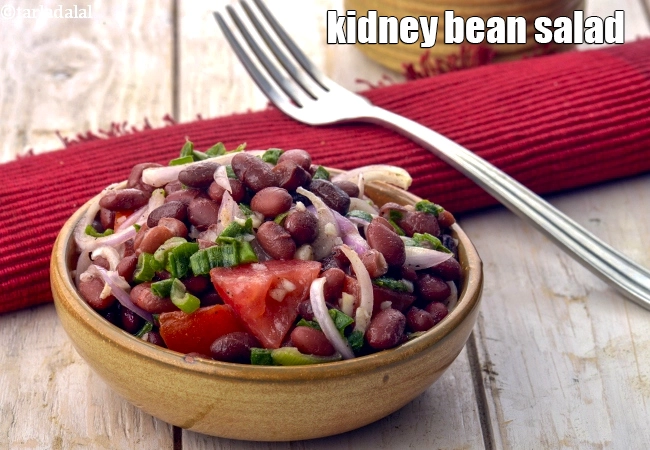
10. Rajma is Good for your Eyes :
Zinc is essential to treat night blindness. Zinc helps in the activity of an enzyme in our body that helps produce Vitamin A , which is useful in treating night blindness.
A colourful platter like in the recipe of Rajma Healthy Vegetable Lunch Salad is sure to please your eyes and benfit your body.
Rajma Vegetable Healthy Lunch Salad, One Dish Meal
Nutritional Information of Rajma, Red Kidney Beans
One cup of cooked Rajma is 150 grams.
RDA stands for Recommended Daily Allowance.
Nutritional Information for 1 cup Cooked Rajma, (Kidney beans, red kidney beans).
173 Calories
17.1 grams of Protein
30.3 grams of Carbs
0.7 grams of Fat
See here total nutritional information of rajma.

Related Articles
Follow US
Recipe Categories
- Vitamin B12 Cobalamin Rich Recipes 33 recipes
- Low Calorie, Weight Loss Indian Recipes 421 recipes
- Low Cholesterol Indian Recipes 308 recipes
- Healthy Indian Breakfast 373 recipes
- Indian Diabetic recipes 559 recipes
- Indian Pregnancy recipes 461 recipes
- Zero Oil Indian Recipes 133 recipes
- Iron Rich Indian recipes 268 recipes
- Healthy Indian Acidity recipes 137 recipes
- Healthy Sabzis 108 recipes
- Indian Healthy Veg Snack 276 recipes
- Healthy Heart Recipes 415 recipes
- Healthy Veg Indian Soups 74 recipes
- Calcium Rich Indian 373 recipes
- High Blood Pressure Indian Recipes 103 recipes
- Healthy Indian Salads Recipes 137 recipes
- Low Carb Indian Diet, recipes 163 recipes
- Hypothyroidism Diet 63 recipes
- Arthritis Diet 68 recipes
- High Protein Indian recipes 95 recipes
- Vitamin K Diet 42 recipes
- Fatty Liver Diet 39 recipes
- PCOS 136 recipes
- Gluten Free Veg Indian 196 recipes
- High Fiber 328 recipes
- Indian Cancer Patients 275 recipes
- Jaundice Diet 45 recipes
- Sprouts 61 recipes
- Typhoid 43 recipes
- Irritable Bowel Syndrome (IBS) 23 recipes
- Kidney Stone Diet 10 recipes
- Home Remedies 213 recipes
- Senior Citizen 195 recipes
- Healthy Indian Drinks and Juices 213 recipes
- Diet for Dialysis 10 recipes
- Gout Indian Recipes 17 recipes
- Potassium Rich 80 recipes
- Vegan 195 recipes
- Indian recipes to treat Vomiting 8 recipes
- Forever Young Diet, Anti Aging Indian Diet 255 recipes
- Antioxidant Rich Indian 445 recipes
- Vitamin B1 Rich Indian Foods, Recipes 101 recipes
- High in Omega 3 Fatty Acids 32 recipes
- Zinc Rich Foods 55 recipes
- Vitamin A Rich, Beta Carotene, Retinol 89 recipes
- Malaria Diet 19 recipes
- Magnesium Rich 94 recipes
- Healthy Indian Dinner 85 recipes
- Vitamin C Rich Indian recipes 118 recipes
- Low Veg Glycemic Index 86 recipes
- Lower Blood Pressure Salads 8 recipes
- Healthy Indian Lunch Recipes 29 recipes
- Lactation 25 recipes
- Vitamin E Rich 51 recipes
- Hyperthyroidism Diet 47 recipes
- Vitamin B3, Niacin Rich 41 recipes
- Post Surgery Diet 42 recipes
- Selenium 27 recipes
- Phosphorus Rich Indian Recipes, Foods 74 recipes
- Lower Blood Pressure Desserts Sweets 14 recipes
- Copper 15 recipes
- Foods Rich in Vitamin B2 Riboflavin 22 recipes
- Vitamin B6 Diet 36 recipes
- B Vitamins 231 recipes
- Vitamin B9 Rich Folate 50 recipes
- Marathoners, Endurance Athletes, Triathlete 225 recipes
- Manganese Diet 32 recipes
- Thalassemia 18 recipes
- Detox Water, Fruit Infused Water 42 recipes
- Lactose Free Dairy Free 22 recipes
- Omega 6 Fatty Acids 32 recipes
- Phytonutrients 51 recipes
- Chronic Kidney Disease Indian recipes 12 recipes
- Selenium1 0 recipes
- Quick Snacks / Quick Starters 385 recipes
- Quick Breakfast Indian 131 recipes
- Quick Sabzis 117 recipes
- Quick Rotis / Parathas 46 recipes
- Quick Indian Sweets 139 recipes
- Quick Stir-Fries 51 recipes
- Quick Vegetarian Indian Soups 72 recipes
- Quick Chutneys 67 recipes
- Quick Vegetarian Rice, khichdi Recipes 56 recipes
- Indian Snacks Under 10 Minutes (Quick Veg Recipes) 44 recipes
- Quick Indian Dips, Gravies & Sauces 105 recipes
- Quick Veg Indian Pizza 17 recipes
- Quick Veg Pasta 25 recipes
- Quick Pickles / Aachar 25 recipes
- Quick Dals / quick Kadhis 29 recipes
- Snacks under 5 minutes 33 recipes
- Quick Healthy Recipes 43 recipes
- Quick Pressure Cooker 46 recipes
- Quick Desserts 47 recipes
- Quick 3 Ingredients 63 recipes
- Quick Indian Desserts 20 recipes
- Quick 4 Ingredients 41 recipes
- Quick 5 Ingredients 42 recipes
- Kids Tiffin Box 319 recipes
- Recipes for Toddlers (1-3 Years) 32 recipes
- Sweet Recipes for Kids 456 recipes
- Recipes for Baby (10 to 12 Months) 17 recipes
- Quick Indian recipes for Kids 72 recipes
- Indian Breakfast Recipes for Kids 192 recipes
- Recipes for Weaning (8 to 9 months) 22 recipes
- Healthy Foods for Kids 196 recipes
- Snack Recipes for Kids 619 recipes
- Recipes Kids can make 36 recipes
- Kids After School 794 recipes
- Kids Jar Snacks 66 recipes
- Finger Foods for Babies, Toddlers and Kids 76 recipes
- Kids Weight Gain 43 recipes
- Kids Wraps and Rolls 23 recipes
- Kids Veg Pasta 27 recipes
- Kids Brain Boosting 68 recipes
- Protein rich food for kids 71 recipes
- Recipes for Weaning 15 recipes
- Kids Pizzas 30 recipes
- Babies, Toddler and Kids Iron Rich Foods 31 recipes
- High Fiber Foods for Kids 39 recipes
- Kids High Energy Indian Foods 103 recipes
- Kids Noodles 37 recipes
- Kids Calcium Rich Indian recipes 92 recipes
- Babies recipes, 6 to 18 months 34 recipes
- Kids Recipes for Increasing Immunity 10 recipes
- Kids Weight Loss 58 recipes
- Teething Recipes for Babies 10 recipes
- Cereals and Pulses for 8 to 9 months Baby 8 recipes
- Weaning foods at 7 months 12 recipes
- Indian Teen 315 recipes
- Starters / Snacks 2138 recipes
- Indian Breakfast Recipes 819 recipes
- Main Course Recipes 925 recipes
- Indian Salads 385 recipes
- Indian Desserts , Sweets 985 recipes
- Indian Soups 249 recipes
- Indian Beverages, Indian Drinks 483 recipes
- Indian Dinner 903 recipes
- Indian Dinner1 0 recipes
- Indian Lunch 829 recipes
- Side Dishes 449 recipes
- Indian Travel Food 433 recipes
- Indian Barbeque1 recipes 22 recipes
- Frozen Foods, Indian Freezer Recipes 67 recipes
- Whole Wheat Recipes 56 recipes
- Indian Comfort Foods 212 recipes
- Dinner Menus 56 recipes
- Easy Indian Veg 70 recipes
- Innovative Indian Recipes 27 recipes
- No Cook Indian 37 recipes
- Advanced Recipes 10 recipes
- Cakes with Eggs 13 recipes
- Microwave 229 recipes
- Oven 619 recipes
- Indian Steamer Recipes 102 recipes
- Kadai Veg 407 recipes
- Indian Barbeque Recipes 43 recipes
- Sizzler tray 15 recipes
- Mixer 566 recipes
- Pressure Cooker 315 recipes
- Tava 647 recipes
- Non-stick Pan 1393 recipes
- Indian Freezer recipes, meals 57 recipes
- Appe Mould 18 recipes
- Pan 223 recipes
- Non Stick Kadai Veg 203 recipes
- kadai Indian 150 recipes
- Refrigerator 176 recipes
- Waffle Indian recipes 6 recipes
- Handi 12 recipes
- Juicer and Hopper 65 recipes
- Grill 31 recipes
- Toaster 21 recipes
- Gas Toaster 8 recipes
- Steam 72 recipes
- No Cooking Veg Indian 335 recipes
- Vegetarian baked Indian recipes 380 recipes
- Boiled Indian recipes 129 recipes
- Deep Fry 260 recipes
- Indian Tawa 265 recipes
- Shallow Fry Indian 25 recipes
- Microwave1 172 recipes
- Saute 273 recipes
- Indian Pressure Cooker 171 recipes
- Stir-fry 101 recipes
- Roasting 0 recipes
.webp)
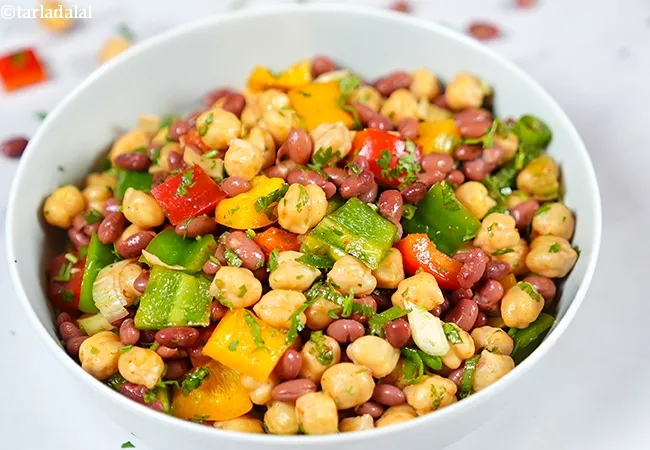

.webp)
